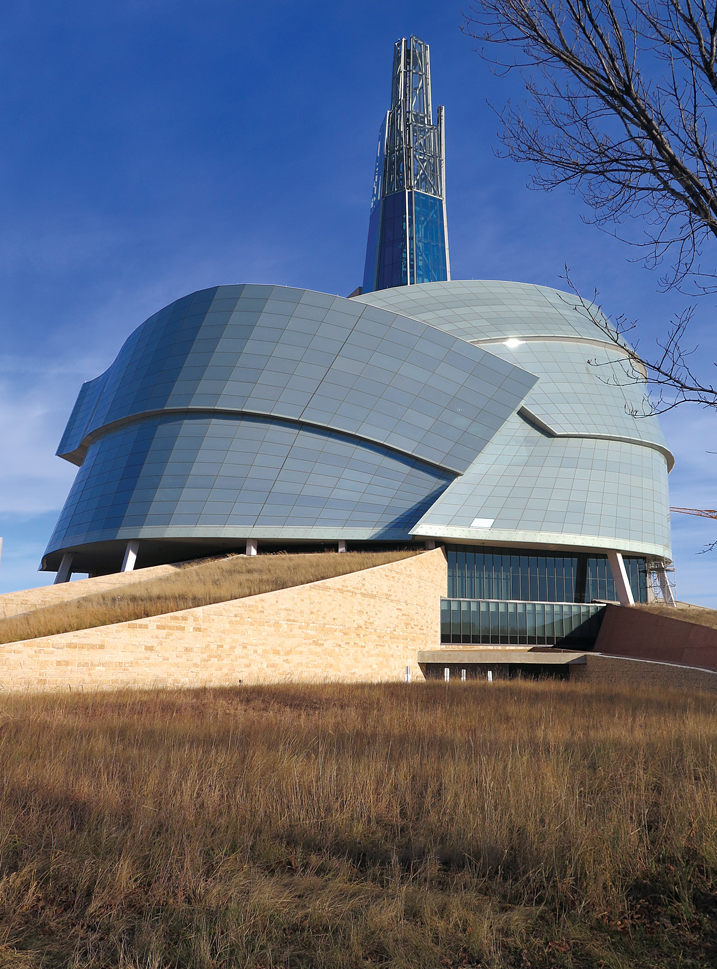
Architect Antoine Predock designed the Canadian Museum for Human Rights. [Sharon Adams]
Stories, a wise person once wrote, help us to see through other peoples’ eyes, show us the consequences of our actions, create community, root us in place and let us fly through time. And teach us how to be human.
That’s a pretty good description of the effect of the Canadian Museum for Human Rights, too. Yes, it has stunning architecture and embodies lofty ideals. But its power resides in the stories it tells, in human voices relating lived experience.
The museum is the legacy of Winnipeg-based businessman and philanthropist Israel Asper. It is Canada’s first national museum located not in the capital, but in the country’s geographical centre. Its mandate is to promote respect for others, to encourage discussion and enhance understanding of human rights in Canada and around the world.
Technology is used to great effect, allowing visitors to be immersed in stories, particularly in exhibits in 360-degree format. Indigenous rights and responsibilities are explored by four generations in a film that wraps around the walls of a circular theatre in the Indigenous Perspective gallery. Virtual reality headgear puts the visitor at the centre of life in a weaving co-operative in Guatemala, where women assert their right to earn a living.
Canada’s human-rights journey is here, too, and it has not been whitewashed. Exhibits address the wrongs of residential schools meant to assimilate aboriginal children, the internment of Japanese Canadians and expropriation of their property and businesses, treatment of black Canadians, the struggle of Chinese-Canadians and women in Quebec to secure the vote, and the turning away of Jewish refugees fleeing Nazism.
But accomplishments are celebrated, too: the battle for women to be considered persons under the law, the growth of laws protecting human rights, including the Charter of Rights and Freedoms and signing of the Universal Declaration of Human Rights, passage of anti-discrimination laws and laws against hate crimes.
The development and refinement of human rights is an ongoing process, as is balancing rights and freedoms. Exhibits acknowledge both processes can be noisy and controversial.
The museum itself has been the focus of several controversies, including the devotion of one gallery to exploring themes of the Holocaust. Critics argued for more emphasis on other atrocities such as the Holodomor in the early 1930s, when somewhere between two and 12 million ethnic Ukrainians starved to death while Soviet leader Joseph Stalin continued to export millions of tonnes of grain in retribution for their opposition to agricultural collectivization.
The Holocaust introduced the notion of genocide—the deliberate extermination of a particular ethnic group or nation. The word was coined by the Polish lawyer and refugee Raphael Lemkin, who documented the Nazis’ systematic extermination of certain groups of people, notably Jews, but also the disabled, homosexuals and intellectuals. He managed to get the term added to indictments in the Nuremburg trials and lobbied for the United Nations Convention on the Prevention and Punishment of Genocide, adopted in 1948.
The gallery shows how Germany’s democratic constitution, democratic elections and checks and balances were slowly manipulated to limit democracy and spread the singular Nazi ideology, how that abuse of state power led to persecution of minority groups and how that developed into a state policy of genocide.
There’s also an exhibit that shows how small acts and decisions, not evil in themselves, can contribute to atrocity.
“Six million deaths don’t just happen all of a sudden,” said researcher/curator Jeremy Maron. Someone drew up the blueprints for the concentration camps on display here, drew up the transport lists for delivering prisoners to camps, filled out the orders for canisters of poison gas.
But someone also offered to shelter Carmella Finkel and her family after nearly all the Jews in their village in Poland had been rounded up and executed. In a video display, Finkel explains how her family spent 20 months in absolute silence in a cramped pit beneath a neighbour’s house with German soldiers in the room directly above. And after the war, someone else sponsored the family to come to Canada, someone related to museum volunteer Joanie Sheps. “My grandparents’ family brought (the Finkels) to Winnipeg…so they could start a new life.”
“The barbarous acts of the Second World War raised the conscience of humankind,” said Maron, and resulted in people working together to protect and promote human rights. Among them, Canadian John Peters Humphrey, director of the United Nations Human Rights Division for two decades.
And the work continues. The Rights Today gallery exhibits show contributions today of actions small and large. On display until March 14 are the Nobel Peace Prize diploma and blood-stained uniform of Pakistani schoolgirl Malala Yousafzai, shot by the Taliban for advocating girls’ rights to education.
“It’s easy to get depressed when we see what still needs to happen all around us,” said Maureen Fitzhenry, media relations manager. But throughout the museum are stories of ordinary people taking action in their everyday lives to promote human rights.
Canadian Paralympic gold medallist Benoît Huot talks about inclusion, and participation in sport for people of all abilities. Speaking volumes is the red prom dress worn by high school student Maréshia Rucker, who recently organized the first integrated prom for students in a Georgia high school, highlighting ongoing racial segregation in the United States. There are also the empty red dresses symbolizing missing and murdered aboriginal women.
High on the wall in the Turning Points for Humanity gallery, a massive projector cycles through the 30 articles of the Universal Declaration of Human Rights. And finally, stories of people working to incorporate human rights into their own lives, people like the women in Saudi Arabia fighting to gain the right to drive.
With that right follows freedom—freedom to go shopping without a male relative, said Maron, and the freedom to escape dangerous situations. It’s stories like this that show how the lofty, abstract ideals of human rights are transformed into human experience.
Advertisement


















